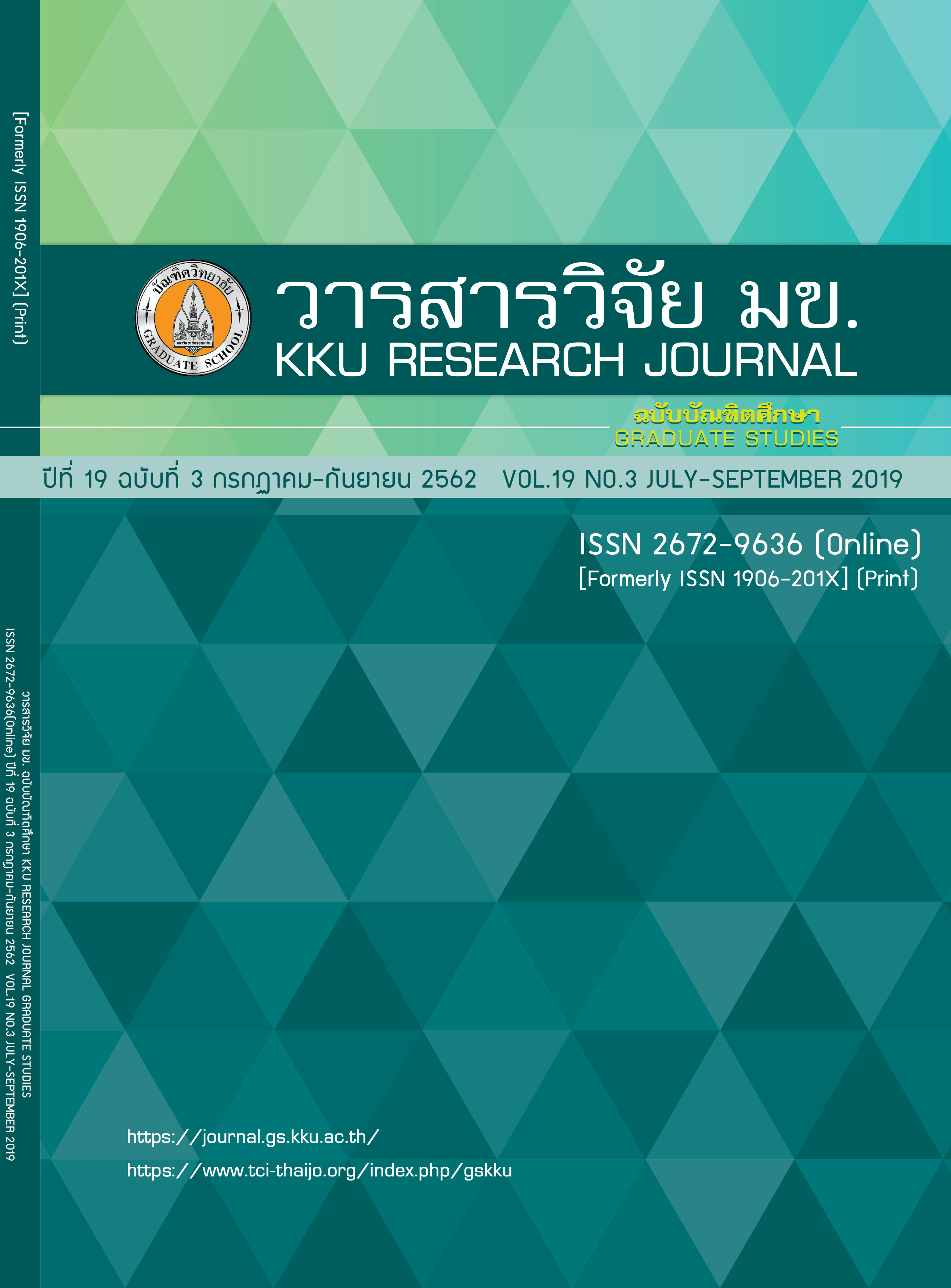Optimization of Activated Carbon Production from Eucalyptus Wood Using H3PO4 as the Activating Agent
Keywords:
Activated carbon, Phosphoric acid, Response surface methodologyAbstract
Activated carbons were prepared from eucalyptus wood residue via chemical activation with H3PO4 as a chemical activating agent. MINITAB (version 16) software was used for investigation the effects of acid concentration (0.5-2 M), carbonizing temperature (500-700๐C) and carbonizing time (60-120 min) on specific surface area. Variance analysis and RSM technique were applied to describe the polynomial model as a function of experimental parameters and its significant parameter. Model with multiple correlation coefficients of determination R2 and Radj2 of 0.9725 and 0.9230, respectively, was proposed. Acid concentration was the most significant factor that influenced on the specific surface area. AC with high specific surface area of 365.254 m2/g was obtained at the optimum condition; 2M of H3PO4, 700๐C and 120 min. Extra investigatain at this condition was done by using smaller precursor impregnated in stronger H3PO4 concentration of 8M. It was found that the activated carbon AC with developing mesoporosity and improved surface area of 812.84 m2/g was produced. The physical and structural properties of activated carbons were characterized by TGA, SEM and FTIR. Also their porous structures were determined by adsorption/desorption of N2 at 77 K.
References
2. Muniandy L, Adam F, Mohamed AR, Ng EP. The synthesis and characterization of high purity mixed microporous/mesoporous activated carbon from rice husk using chemical activation with NaOH and KOH. Microporous and Mesoporous Materials. 2014 Oct 1; 197:316-23.
3. Kumar A, Jena HM. Preparation and characterization of high surface area activated carbon from Fox nut (Euryale ferox) shell by chemical activation with H3PO4. Results in Physics. 2016 Jan 1; 6:651-8.
4. Heidari A, Younesi H, Rashidi A, Ghoreyshi A. Adsorptive removal of CO2 on highly microporous activated carbons prepared from Eucalyptus camaldulensis wood: Effect of chemical activation. Journal of the Taiwan Institute of Chemical Engineers. 2014 Mar 1;45(2):579-88.
5. Yakout SM, El-Deen GS. Characterization of activated carbon prepared by phosphoric acid activation of olive stones. Arabian Journal of Chemistry. 2016 Nov 1;9: S1155-62.
6. Wang B, Li Y, Si H, Chen H, Zhang M, Song T. Analysis of the Physical and Chemical Properties of Activated Carbons Based on Hulless Barley Straw and Plain Wheat Straw Obtained by H3PO4 Activation. BioResources. 2018 May 18;13(3):5204-12.
7. Duan X, Srinivasakannan C, Wang X, Wang F, Liu X. Synthesis of activated carbon fibers from cotton by microwave induced H3PO4 activation. Journal of the Taiwan Institute of Chemical Engineers. 2017 Jan 1; 70:374-81.
8. Valizadeh S, Younesi H, Bahramifar N. Preparation and Characterization of Activated Carbon from the Cones of Iranian Pine Trees (Pinus eldarica) by Chemical Activation with H3 PO4 and Its Application for Removal of Sodium Dodecylbenzene Sulfonate Removal from Aqueous Solution. Water Conservation Science and Engineering. 2018:1-3.
9. Vunain E, Kenneth D, Biswick T. Synthesis and characterization of low-cost activated carbon prepared from Malawian baobab fruit shells by H3PO4 activation for removal of Cu (II) ions: equilibrium and kinetics studies. Applied Water Science. 2017 Dec 1;7(8):4301-19.
10. Kolodynska D, Krukowska J, Thomas P. Comparison of sorption and desorption studies of heavy metal ions from biochar and commercial active carbon. Chemical Engineering Journal. 2017 Jan 1; 307:353-63.
11. Chen Z, Zhu Q, Wang X, Xiao B, Liu S. Pyrolysis behaviors and kinetic studies on Eucalyptus residues using thermogravimetric analysis. Energy Conversion and Management. 2015 Nov 15; 105:251-9.


